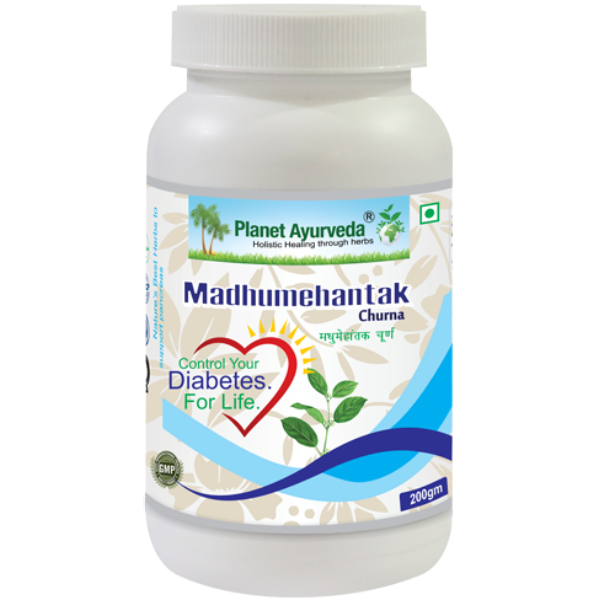Madhumeha/Diabetes in Ayurveda – Causes, Symptoms & Natural Herbal Treatment
Abstract
Diabetes mellitus (DM) remains one of the most widespread endocrine and metabolic disorders globally, marked by persistent elevation of blood glucose levels. According to the International Diabetes Federation (IDF), the prevalence of diabetes among adults aged 20–79 was approximately 10.5% in 2021. In India alone, more than 77 million individuals were living with diabetes, placing the country among the highest in global disease prevalence. It’s concerning to note that by the year 2050, nearly 1 in 8 adults across the globe, roughly 853 million people, are expected to be living with diabetes. That’s a staggering 46% rise from current estimates, highlighting just how serious and widespread this condition is becoming. While modern antidiabetic medications offer glycemic control, they often come with undesirable side effects such as hypoglycemia, weight gain, and gastrointestinal disturbances. This has prompted growing interest in safer, holistic alternatives, particularly classical polyherbal formulations such as Madhumehantak Churna. This formulation is composed of time-tested Ayurvedic herbs and is renowned for its unique therapeutic roles. This study is undertaken to evaluate the inhibitory effect of Madhumehantak Churna on α-amylase and α-glucosidase enzymes, which play a central role in carbohydrate digestion and postprandial blood glucose elevation.

Introduction
Diabetes mellitus, known in Ayurveda as Madhumeha, is a chronic metabolic disorder characterized by persistent hyperglycemia resulting from defects in insulin secretion, insulin action, or both. It is a multifactorial condition that affects the metabolism of carbohydrates, proteins, and fats, leading to a wide range of systemic complications if not properly managed. In modern medical science, Diabetes mellitus is broadly classified into Type 1 and Type 2, with Type 2 being the most prevalent form, often associated with insulin resistance, obesity, and a sedentary lifestyle. One of the earliest pathophysiological events in Type 2 Diabetes Mellitus is postprandial hyperglycemia, the abnormal rise in blood glucose levels after meals. This occurs due to rapid digestion and absorption of dietary carbohydrates, mediated by digestive enzymes such as α-amylase, which breaks down complex starches into oligosaccharides, and α-glucosidase, which further converts them into glucose for absorption.
In Ayurveda, Madhumeha (diabetes) is understood as a chronic metabolic disorder falling under the broader category of Prameha (urinary disorders), primarily resulting from Agnimandya (weakened digestive fire) and Medo Dhatu dushti (vitiation of adipose tissue).
Ayurvedic Pathogenesis Of Madhumeha (Diabetes)
Due to improper dietary habits, such as excessive intake of heavy, oily, and sweet foods and a sedentary lifestyle, Kapha dosha becomes aggravated and leads to the formation of Ama (undigested toxic waste), which obstructs bodily channels. This blocks the normal function of Medovaha (fat-transporting) and Mutravaha srotas (urine-carrying channels), resulting in excessive Kleda (fluid) accumulation. As the disease progresses, Vata dosha also becomes vitiated due to Dhatukshaya (tissue depletion), particularly affecting Meda dhatu (fat tissue), Rakta dhatu (blood tissue), and Shukra dhatus (reproductive tissue), leading to Dhatu shaithilya (loss of tissue integrity). This leads to Dhatu shaithilya (loss of tissue integrity), which manifests as the classical symptoms of Madhumeha, including:
- Prabhuta mutrata (frequent urination)
- Madhura mutra (sweet urine)
- Klama (fatigue)
- Trishna (excessive thirst)
- Karshya (emaciation)
This shows that Madhumeha is not just a disease of high blood sugar, but a systemic disorder involving Agni (digestive fire), Doshas (body humors), Dhatus (body tissues), and Srotas (body channels).
Modern Medical View Of Diabetes Mellitus
In modern medicine, diabetes mellitus is diagnosed based on:
- Fasting and postprandial blood glucose levels
- HbA1c (for long-term glycemic control)
- Clinical symptoms like polyuria, polydipsia, fatigue, and weight loss/gain
Early diagnosis is essential, especially in individuals with risk factors such as:
- Obesity
- Sedentary lifestyle
- Family history of diabetes
- Metabolic syndrome or insulin resistance
Modern Treatment Approach For Type 2 Diabetes
The pharmacological treatment of Type 2 Diabetes Mellitus includes:
- Metformin (improves insulin sensitivity)
- Sulfonylureas (stimulate insulin release)
- DPP-4 inhibitors, SGLT2 inhibitors, and thiazolidinediones
- GLP-1 receptor agonists and insulin (injectables)
Most importantly, these treatments focus on controlling symptoms rather than addressing the root cause of the disease. While effective in reducing blood sugar, these medicines have limitations such as:
- Gastrointestinal side effects
- Weight gain
- Risk of hypoglycemia
- Dependence on long-term use
Ayurvedic Management Of Madhumeha
In Ayurveda, the focus is on restoring balance in the body by correcting the underlying disturbances. Management includes:
- Agnideepan (stimulating digestive/metabolic fire)
- Medohara Chikitsa (addressing adipose tissue imbalance)
- Shodhana (cleansing of blocked Srotas)
- Rasayana (rejuvenation of tissues)
This holistic approach involves:
- Dietary corrections (Pathya-Apathya)
- Lifestyle changes (Dinacharya and exercise)
- Herbal formulations with proven actions on metabolic regulation
Material And Method
Composition Of Madhumehantak Churna
- Saptrangi (Salacia chinensis)
- Vizaysaar (Pterocarpus marsupium)
- Bilva Patra (Aegle marmelos)
- Gurmaar (Gymnema sylvestre)
- Daruharidra (Berberis aristata)
- Neem Patra (Azadirachta indica)
- Methi Seeds (Trigonella foenum-graecum)
- Jamun Seeds (Syzygium cumini)
- Karela (Momordica charantia)
- Tulsi Leaves (Ocimum sanctum)
- Sadabahar (Catharanthus roseus)
- Babool Bark (Acacia arabica)
Description Of Ingredients
1. Saptrangi (Salacia chinensis)
This herb has Kapha-hara (Kapha-reducing), Agnideepana (enhancing the digestive fire), and Kleda-shoshana (absorbing excessive pathological moisture) actions. These properties make it particularly beneficial in the management of Prameha (a clinical entity comparable to diabetes mellitus). This herb acts on Medo dhatu (fat tissue) and Mootravaha srotas (urinary system), helping regulate abnormal metabolism and excessive urination. It contains active compounds such as salacinol, kotalanol, and mangiferin, which have shown strong α-glucosidase inhibitory activity, even more potent than acarbose in suppressing postprandial blood sugar spikes in maltose and sucrose tolerance tests in animal models. These bioactives slow down carbohydrate digestion and glucose absorption, contributing to better postprandial glycemic control. Furthermore, Salacia extracts exhibit α-amylase inhibition, downregulate hepatic gluconeogenic enzymes, and enhance peripheral insulin sensitivity, offering a comprehensive mechanism for glycemic regulation.
2. Vizaysaar (Pterocarpus marsupium)
It is categorized under Medohara (fat-reducing), Kapha-shamaka (Kapha-pacifying), and Agnideepana (digestive stimulant) herbs. It is particularly effective in correcting Agnimandya (low digestive fire) and in promoting Mutravirechana (urinary cleansing), making it highly suitable for the management of Prameha (Urinary disorders) and Madhumeha (diabetes mellitus). The extracts derived from its heartwood have demonstrated potent α-amylase inhibitory activity, with IC₅₀ (Inhibitory Concentration 50%) values around 59 µg/mL when delivered via chitosan-based nanoparticles. This inhibition slows the enzymatic breakdown of dietary starch, thereby reducing postprandial glucose spikes. Additionally, the herb is rich in antioxidants and exhibits significant anti-inflammatory action, which further aids in countering oxidative stress and low-grade inflammation, which are two key contributors to insulin resistance and β-cell dysfunction in type 2 diabetes.
3. Bilva Patra (Aegle marmelos)
It is recognized for its Tridosha-hara action, with a specific emphasis on Kapha-Vata shamana (pacifying Kapha and Vata doshas). Bilva Patra (the leaves) are particularly esteemed for their Deepana (appetite-stimulating), Bhedana (mild laxative), and Shothahara (anti-inflammatory) properties, which support both Agnimandya (sluggish metabolism) correction and Shroto-shodhana (channel cleansing). The presence of potent bioactive constituents such as aegeline, marmelosin, and skimmianine, all of which exhibit strong α-amylase and α-glucosidase inhibitory activity. In one in-vitro study, aqueous extracts of Bilva Patra inhibited α-glucosidase with an IC₅₀ of approximately 80 μg/mL and α-amylase with an IC₅₀ of around 60 μg/mL, signifying their potential in delaying carbohydrate breakdown and absorption, thus minimizing postprandial glycemic spikes. Additionally, its antioxidant and β-cell protective effects further contribute to pancreatic health and glucose homeostasis.
4. Gurmaar (Gymnema sylvestre)
“Gurmaar”, literally meaning the “sugar-destroyer” in Sanskrit, holds a distinguished place in the Ayurvedic management of Madhumeha (diabetes mellitus). It is classified under Kaphahara (Kapha-pacifying) and Vatashamaka (Vata-pacifying) herbs. It is acclaimed for its Agnideepana (digestive fire-enhancing) and Rasa-vinashaka (taste-modifying) actions. The leaves of Gurmaar are particularly noted for their ability to suppress the perception of sweetness on the tongue, a unique effect that supports the control of sugar cravings and helps correct Aahara-janya hetu (dietary causation) in Madhumeha. It is rich in gymnemic acids, a group of triterpenoid glycosides, which have shown dose-dependent inhibition of both α-glucosidase and α-amylase enzymes. The IC₅₀ values for these enzyme inhibitions are comparable to acarbose (a conventional anti-diabetic drug). Furthermore, a purified TG fraction (triterpene glycoside) demonstrated sucrase inhibition with an IC₅₀ of ~74 µg/mL, and potent yeast α-glucosidase inhibition at just ~3 µg/mL. This shows that it has powerful potential to lower blood sugar levels after meals.
5. Daruharidra (Berberis aristata)
It is considered a potent Kapha-Pitta Shamak (pacifier of Kapha and Pitta doshas) as well as a Pramehaghna dravya (anti-diabetic agent). It is used for managing Diabetes, Kustha (chronic skin disorders), and Netra Roga (eye diseases), reflecting its Raktashodhaka (blood purifying), Krimighna (antimicrobial), and Stambhana (astringent) properties. It supports Rasa dhatu shuddhi (purification of plasma) and strengthens the Agnimandya (sluggish digestion). The principal bioactive component of Berberis aristata is berberine, an isoquinoline alkaloid extensively studied for its dual inhibition of α-amylase and α-glucosidase enzymes. In vitro findings show that berberine inhibits α-amylase with an IC₅₀ of approximately 40.5 μg/mL and α-glucosidase with an IC₅₀ of around 22.3 μg/mL, effectively delaying carbohydrate breakdown and glucose absorption. Furthermore, berberine activates the AMP-activated protein kinase (AMPK) pathway, which plays a vital role in improving insulin sensitivity, suppressing hepatic gluconeogenesis, and enhancing glucose uptake in peripheral tissues.
6. Neem Patra (Azadirachta indica)
It is classified under Tikta-Kashaya rasa (bitter-astringent taste) and is highly regarded for its potent Kaphahara (Kapha-reducing), Shothahara (anti-inflammatory), and Pramehaghna (anti-diabetic) properties. With its bitter taste and light, dry qualities, it effectively alleviates these derangements by srotoshodhana (cleansing the microchannels), enhancing Agni (digestive fire), and reducing excessive Kleda (pathological fluid retention). Its leaves contain bioactive flavonoids and limonoids such as quercetin, nimbin, and azadirachtin, which exhibit significant inhibitory activity against carbohydrate-digesting enzymes. Specifically, α-glucosidase inhibition has been observed with an IC₅₀ of approximately 50 μg/mL, and α-amylase inhibition with an IC₅₀ of around 85 μg/mL. These actions delay intestinal glucose absorption and help blunt postprandial glycemic surges. Additionally, Neem has been shown to promote pancreatic β-cell regeneration, enhance insulin secretion, and reduce oxidative stress, which are vital in preventing long-term diabetic complications.
7. Methi Seeds (Trigonella foenum-graecum)
It is widely recognized in Ayurveda for its Deepana (digestive stimulant), Pachana (digestive), and Medohara (fat-reducing) properties. It enhances Agni (digestive and metabolic fire), facilitates the breakdown of Ama (metabolic toxins), and promotes the healthy transformation of Meda dhatu (adipose tissue), which is often vitiated and accumulated in diabetic individuals. Fenugreek seeds are rich in soluble fibers, especially galactomannan, which delays gastric emptying and carbohydrate absorption. Moreover, extracts of Fenugreek seeds have shown strong α-amylase and α-glucosidase inhibitory activities, which effectively reduce postprandial hyperglycemia by slowing down the enzymatic digestion of complex carbohydrates.
8. Jamun Seeds (Syzygium cumini)
It possesses Kaphahara (Kapha-pacifying) and Raktashodhaka (blood-purifying) properties, making it especially beneficial in Madhumeha (diabetes). Its Kashaya (astringent) and Tikta (bitter) tastes help control excessive Mutrata (urination) and correct Kapha-Meda dushti (disturbed fat and fluid metabolism). With Shoshana (absorptive) and Stambhana (astringent) actions, it tones the urinary tract and reduces Kleda (pathological moisture), acting on both Mootravaha and Medovaha srotas (urinary and fat channels). Its active compounds are jamboline and ellagic acid, which improve glucose metabolism, boost insulin sensitivity, and support β-cell function. Their antioxidant and anti-inflammatory properties also help counter oxidative stress linked to chronic hyperglycemia.
9. Karela (Momordica charantia)
It is traditionally referred to as Tikta rasa pradhana dravya (predominantly bitter-tasting herb). The Tikta (bitter) and Kashaya (astringent) tastes, along with its Laghu (light) and Ruksha (dry) gunas (qualities), make it especially effective in pacifying Kapha and Pitta doshas, the two primary doshas involved in the manifestation of Madhumeha (diabetes). Madhumeha (diabetes) is a Santarpanajanya Vyadhi (disease caused by over-nourishment), primarily involving Kapha-Meda Dushti (vitiation of Kapha dosha and adipose tissue). Karela’s Medohara (fat-reducing) property helps remove excess Meda Dhatu (body fat), clears Srotorodha (blockage of bodily channels), and restores normal Vata Gati (movement of Vata dosha). This is essential, as obstructed Vata leads to Ojas Kshaya (depletion of vital energy) and disturbance in Mutravaha Srotas (urinary channels), causing glycosuria (sugar in urine) and other diabetic symptoms. It has several active phytoconstituents such as charantin (a potent steroidal saponin), vicine, and polypeptide-p (a plant-derived insulin-like peptide). These compounds exert significant α-glucosidase and α-amylase inhibitory effects, which reduce the enzymatic conversion of complex carbohydrates into glucose. Karela extracts exhibit α-glucosidase inhibition with IC₅₀ values as low as 20.1 μg/mL and α-amylase inhibition at around 35.8 μg/mL.
10. Tulsi Leaves (Ocimum sanctum)
It is considered a powerful Rasayana (rejuvenative) and adaptogen, with strong Kapha-Vata shamaka (Kapha and Vata-pacifying) effects. Traditionally, it is used in Jwara (fevers), Kasa-Shwasa (cough and respiratory issues), and Prameha (metabolic disorders like diabetes). In Madhumeha (diabetes), it works as a Medohara (fat-reducing), Shothahara (anti-inflammatory), and Hridaya Balya (heart-strengthening) herb. It has bioactive compounds such as eugenol, ursolic acid, apigenin, and flavonoids, which exert α-amylase and α-glucosidase inhibitory activity, thus slowing down carbohydrate digestion and intestinal glucose absorption. It exhibits potent antioxidant and anti-inflammatory effects that protect pancreatic β-cells from oxidative damage.
11. Sadabahar (Catharanthus roseus)
It has Madhumehahara (antidiabetic) effect. It is known to pacify Kapha and Pitta doshas and is often employed to alleviate classical symptoms of Madhumeha (diabetes) such as Prabhuta Mutrata (excessive urination), Daurbalya (weakness), and fatigue. Its leaves have demonstrated strong α-glucosidase and α-amylase inhibitory actions, thereby helping to reduce postprandial glucose levels. Additionally, the presence of bioactive alkaloids such as vincristine and vinblastine contributes to cellular protection, improved insulin sensitivity, and potential β-cell preservation.
12. Babool Bark (Acacia Arabica)
It is considered a Kashaya Rasa-dominant drug with Grahi (absorbent), Stambhana (astringent), and Kapha-pacifying properties. It is commonly used to manage excessive secretions, including frequent urination seen in Madhumeha (diabetes). The bark has a cooling and drying effect on the body and supports proper urinary functioning. Extracts of its bark demonstrate significant α-glucosidase inhibition, reducing intestinal glucose uptake. Its rich tannin and polyphenol content not only imparts astringency but also contributes to its enzyme-inhibiting and antioxidant properties, making it beneficial in controlling both blood sugar and associated complications of diabetes.
Mode Of Intake
Take 1 to 2 teaspoons of the powder twice daily, preferably 30 minutes before meals. It can be consumed with plain water, sugar-free iced tea, or apple juice for better palatability and effectiveness.
Doshic (Body Humors) Correction In Madhumeha
It possesses strong Kaphahara (Kapha-reducing) and Vatashamaka (Vata-pacifying) properties, which help correct the primary doshic imbalance seen in Madhumeha (diabetes).
Indications
- Madhumeha (Diabetes Mellitus)
- Prameha (Urinary Disorders)
- Meda Roga (Disorders of Fat Metabolism)
- Agnimandya (Low Digestive Fire)
- Trishna (Excessive Thirst)
- Klama (Fatigue)
- Daurbalya (Weakness)
- Polyuria
- Glycosuria
- Impaired Carbohydrate Metabolism
Pathya (Recommended Diet & Lifestyle)
- Yava (Barley), Kodrava (Kodo Millet), and Shyamaka (Barnyard Millet) – Easily digestible grains that help reduce excess Kapha and Meda (fat tissue).
- Tikta (bitter), Kashaya (astringent), and Katu (pungent) taste-dominant foods – Help pacify Kapha and regulate metabolism.
- Green leafy vegetables – Particularly bitter ones like neem, methi (fenugreek), and karela (bitter gourd).
- Old rice (1-year-old), moong dal, and horse gram – Light and nourishing while being suitable for diabetic metabolism.
- Regular physical activity or brisk walking – Enhances Agni (digestive fire), prevents Meda Dhatu vitiation, and supports healthy Srotas (channels).
- Triphala, turmeric, and cinnamon – Support insulin sensitivity and act as mild blood sugar regulators.
- Lukewarm water intake – Supports digestion and prevents Ama (toxins).
- Dinacharya (daily routine) and Ritucharya (seasonal regimen) – Help regulate biological rhythms and doshas (humors).
Apathya (To Be Avoided)
- Excessive intake of Guru (heavy), Snigdha (oily), and Madhura (sweet) foods aggravates Kapha and Meda (fat tissue), worsening blood sugar imbalance.
- Foods made from refined flour, white rice, potatoes, sugar, and processed snacks.
- Dairy products like curd (especially at night), sweets, and fried foods.
- Sedentary lifestyle, Divaswapa (excessive sleeping during the day), and mental stress.
- Cold water and carbonated drinks impair Agni (digestive fire) and promote Ama (toxin) formation.
- Alcohol and smoking disturb Agni (digestive fire), Srotas (body channels), and overall metabolism.
- Skipping meals or irregular eating habits disrupts Pitta and leads to hypoglycemia or cravings.
To buy Madhumehantak Churna, please visit store.planetayurveda.com/products/madhumehantak-churna
Conclusion
Madhumehantak Churna is a classical Ayurvedic herbal blend that shows strong potential in managing diabetes, especially by targeting enzymes like α-amylase and α-glucosidase. These two enzymes play a key role in breaking down carbohydrates into glucose after meals. When their activity is slowed down, the rise in blood sugar levels after eating (postprandial blood glucose) is also controlled. The formulation also helps in improving insulin sensitivity, reducing oxidative stress, and supporting better glucose metabolism. This multi-targeted approach makes Madhumehantak Churna a useful supportive therapy in the management of Type 2 Diabetes.




